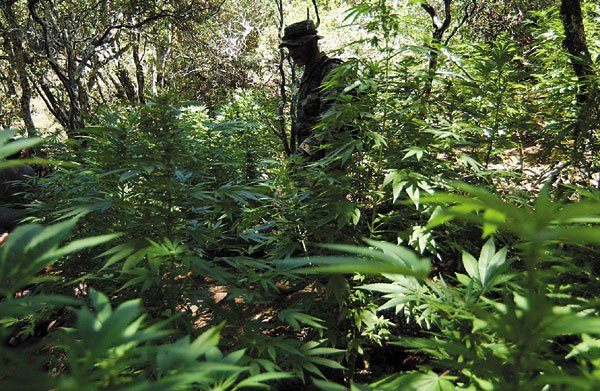A multi-million dollar bust eradicates more than 10,000
marijuana plants in Mount Madonna County Park
By Jessica Thy Nguyen Special to the Dispatch
Gilroy – An estimated $40 million worth of marijuana found in Mount Madonna County Park west of Gilroy was destroyed Tuesday by the Santa Clara County Sheriff’s Special Operations Division.
A mile and a half from Hecker Pass Highway, eight gardens – known as grows – were found amongst the manzanita and native brush of the park.
Each of the grows were located in canopied areas, where sunlight could get through during parts of the day, but still be sufficiently hidden by low-flying planes, a deputy of the Special Operations Division said.
The total number of plants uncovered in the area amounted to at least 10,000 plants, at a street value of $4,000 per plant, according to Santa Clara County Sheriff’s Deputy Serg Palanov.
This year’s marijuana season started in July and so far, the amount of plants uncovered in Santa Clara County by the special operations division has surpassed last year’s 80,000 plants.
“Just to give you an idea so far this year,” Deputy Serg Palanov said, “we’ve [already] gathered roughly around 70,000 plants.” This count does not include Tuesday’s bust, and the street value of the destroyed plants before Tuesday was $280 million.
“We’ve just been getting more efficient at finding the grows, but also it means there have been more out there,” a special operations division deputy said of the higher number of busts this year.
This year’s season is estimated to be more bountiful than last year’s mainly because of the abundant rainfall that occurred as plants were planted in spring, Palanov said.
A rigorous hike through makeshift trails over steep terrain, overgrown with manzanita and poison oak, was necessary in order to access the growing areas. A deputy said the grows found Tuesday were located closer to public access compared to other busts, even though they were more than a 30-mile hike from the end of a Sprig Lake service road to the first grow sites within park grounds.
“As usual when they hike into any of these gardens they always find more gardens. At this point there are four gardens and they’ll probably find a couple more,” Deputy Palanov said before the hike into the park. By the time the operation was complete, eight gardens were located and destroyed.
The sites are hundreds of feet apart and even farther from any natural source of water. In order to irrigate the plants, growers connect a hose from an irrigation ditch to water barrels and then to the separate grow sites with a gas-powered water pump.
“They’ll also build what’s called a check dam where they’ll dig holes into the earth and they’ll line it usually with plastic. They’ll use that to conserve and store water so that when their original source runs out they’ll tap into check dams that they’ve built and collected water over the summer,” he said.
Environmental issues are involved with growing sites because of the amount of damage that is done.
“[The cultivators] are changing the terrain of the land, causing erosion and eventually trees falling,” Special Operations Division Deputy Joe Waldherr said. “They use pesticides to keep out the rodents and also fertilizer for the plants. They also poach [the wildlife] for food.”
A gas stove, bags filled with trash, some beer cans and a bag of rice were all that remained of a campsite located in-between grow sites. No suspects were apprehended or spotted during the time the deputies were there.
The deputies eradicated the immature plants by chopping them down. The sellable portion of the marijuana plant is found in the buds of matured plants.
“No, these plants are not mature, it’s easier for us to do eradications,” a special operations division deputy said. “We don’t have to actually lift out every single plant.”
Matured plants have to be air-lifted out by helicopter because the buds can be harvested after the plant has been chopped down. Smaller amounts of matured plants found are cut up in order to prevent harvest of any buds.













